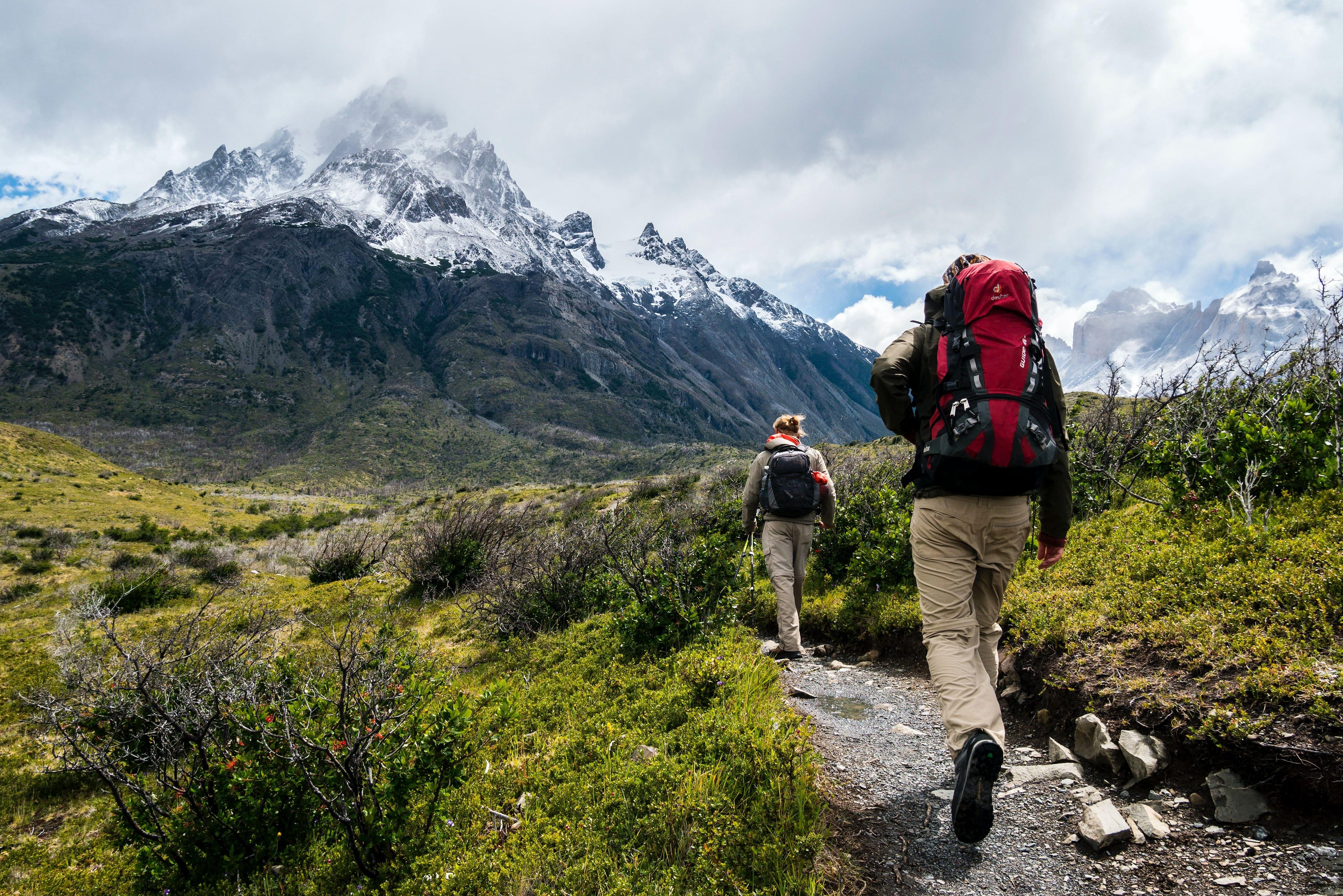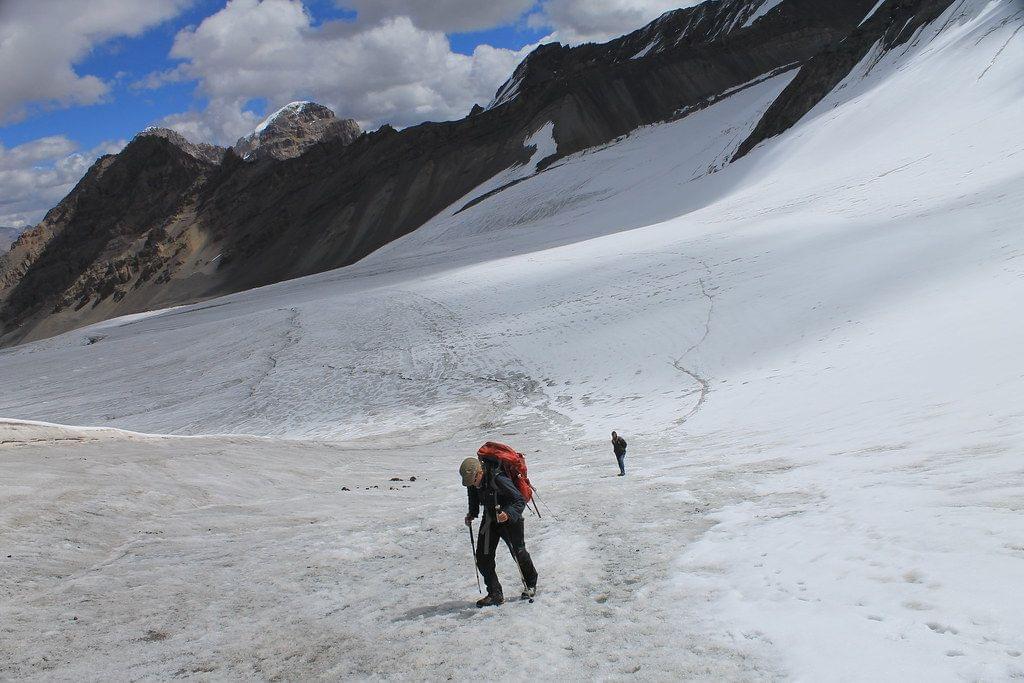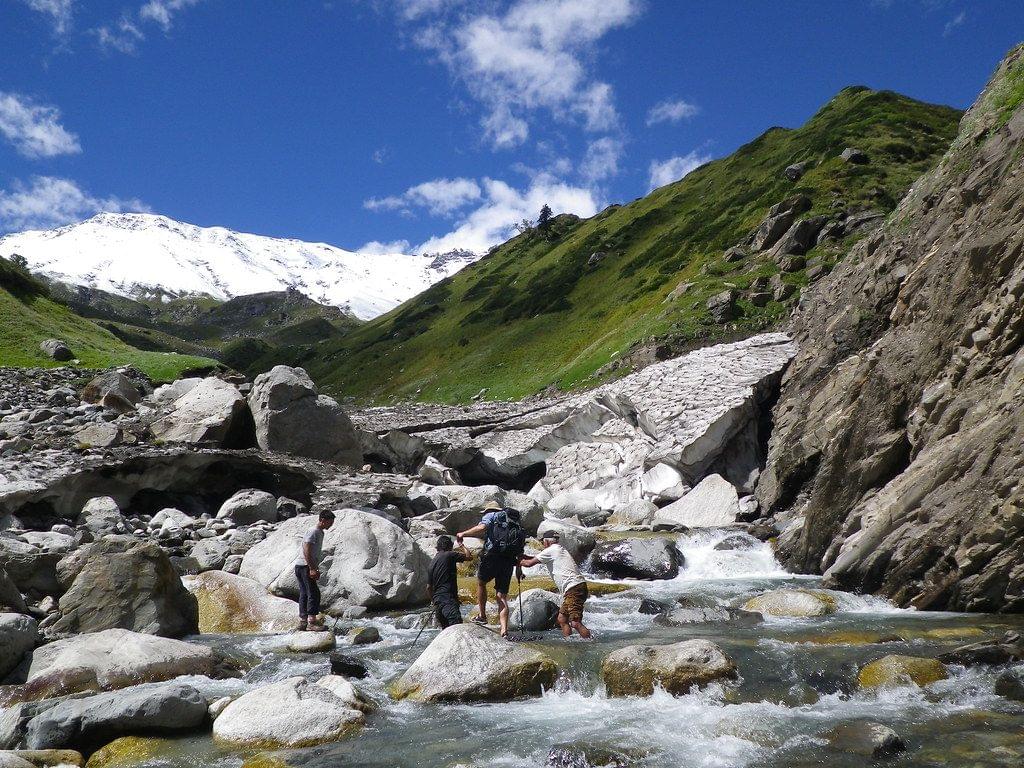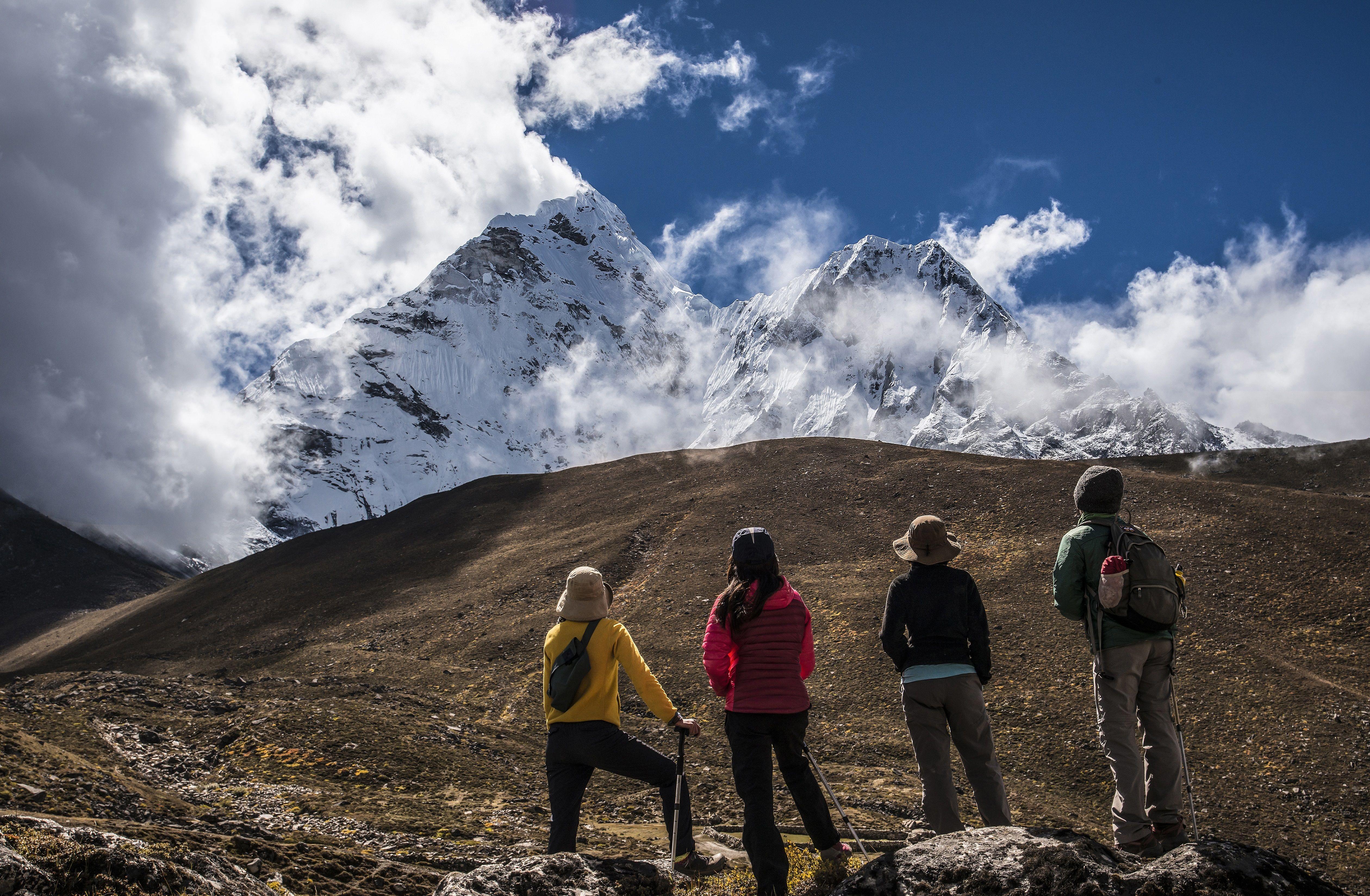Deo Tibba Base Camp Trek Overview
Quick Facts of Deo Tibba Base Camp Trek
Maximum Altitude: The Deo Tibba trekking takes participants 4480 meters above sea level.
Grade: Medium to Difficult
Duration: 6 days and 5 nights
Trekking distance: 35 km
Trail type: High altitude with scenic landscape and awe-inspiring views of constantly changing terrain and the trail is steep and stony.
Railhead: Jogindernagar Railway station which is at least 5 hours away.
Airport: Bhuntar airport in Kullu, which is located at a distance of 52 km from Manali.
Snow Season: The snow season starts in November and continues till Feb or even March.
Service from: Manali
Base camp: Jagatsukh, located at a distance of 11 km from Manali.
Best season: From May to October.
Region: Himachal Pradesh
Who can participate: Physically fit adults over the age of 18 years and with basic mountaineering experience.
Short Itinerary for Deo Tibba Base Camp Trek
Deo Tibba Base Camp Trek Detailed Itinerary
Drive from Manali to Khanol village and trek to Chhikka
The participants of the Deo Tibba trek reach Manali and take a bus ride to Jagatsukh.
From Jagatsukh they hire a vehicle to Baara Hazar and find the trail located to the left of Duhangan Dam Control Room.
The trail leads into the woods and features a bridge connecting to the left of the valley.
The moderately difficult trek is 5 km long and takes around 2 to 3 hours.
The gradual climb following the first 15-20 minutes of steep climb ends at Chhikka located at an altitude of 3200 meters.
Trekking from Chhikka to Seri
As the participants start trekking along the banks of Jagatsukh Nallah they are led into the brilliant forests.
The forests give way to a beautiful landscape of soft velvety grass and vibrant wildflowers and paths strewn with boulders.
The climb across the beautiful meadows of Seri commences just beyond the tree line.
The moderate ascent takes the participants to an altitude of 3900 meters.
The trek requires the participants to cover a distance of 6 km and is completed in 5 to 6 hours.
Trekkers can enjoy the mesmerizing beauty of the region before retiring for the night in their camps.
Trek from Seri to Tainta
As part of the day’s trek, the participants walk across a flat meadow and wade through the streams that feed the Jagatsukh Nallah.
This is followed by a steep climb through the boulders leading to a Moraine field where the participants can enjoy the first view of Deo Tibba and Indrasan peaks.
The moderate to steep trek takes the participants to an altitude of 4171 meters above sea level.
The total trekking distance covered on day three is 4 km and it is completed in 4-5 hours.
The participants get enough time to relax and acclimatize before sleeping in their tents.
Trek from Tainta to Chandratal and back
The participants undertake an uphill climb across moraine fields to arrive at the emerald blue glacial lake called Chandratal.
The participants are left mesmerized by the sight of the countless wildflowers growing on the banks of the lake.
Participants can relax and see the natural beauty of the area before commencing their journey back to Tainta.
This section of the Deo Tibba trek takes the participants to an altitude of 4480 meters above sea level.
The moderate trek covers a distance of 2 km and is completed in 2 to 3 hours.
Descent from Tianta to Chhikka
This is the first day of the descent and will require the participants to trace back their steps to Chhikka.
The descent is quite easy and even enjoyable and takes far less time than the ascent.
However, participants need to exercise control while moving down the steep incline as descending at a fast speed can be risky.
The trekkers will halt for lunch at Dudu Pathar before commencing their downward journey.
The entire trip can be completed in around 6 to 7 hours depending on the weather conditions.
The participants will spend the night relaxing in their tents at the Chhikka campsite.
Descent from Chhikka to Khanol followed by the drive to Manali
On the last day of the trip, the participants trek back from Chhikka to Khanol village and Baara Hazar
Upon reaching Baara Hazar the participants take a ride back to Manali.
The trek back mostly involves walking across the meadows or moving downhill and can be completed in 2-3 hours.
The participants may spend some time in Solang valley before going to Manali.
They can participate in the various adventure activities that Solang is famous for including paragliding and zorbing.
They can also spend time exploring the local markets in Manali before heading back home.
What To Pack for Deo Tibba Base Camp Trek?
Participants should make sure to pack the following things to make sure that their Deo Tibba trek proves to be one of the best experiences of their life.
Backpack: Every participant should carry a backpack with a minimum capacity of 50 to 60 liters and wide and comfortable shoulder straps. The backpack should be able to hold the various items that the participants need to carry along on the trekking trail.
Water Bottle: Staying hydrated during the trek is extremely important and participants should pack two water bottles of 1 liter capacity each as they are easy to carry compared to a single 2 liters bottle.
Clothes: Irrespective of the season they choose to undertake the trekking trip, participants must pack warm clothes including thermals, woolen caps, mitten, scarves, several pairs of socks, and even a fleece jacket.
Personal Medical Kit: Participants should make sure to pack their medical kit with all the medicines they need to take regularly as well as those they might require during the trip including emergency first-aid essentials.
Snacks And Toiletries: All participants must pack their toiletries along with a snacks package comprising energy bars, dry fruits, and ORS packets.
Other Essential Items: The participants should pack a valid id-proof along with its copies, enough cash to pay for any extra services, essential prescriptions, and medical records, as well as mobile chargers and extra batteries. It is advisable to pack these essentials separately and place them at the bottom of the backpack or in a separate compartment.
Know Before You Go for Deo Tibba Base Camp Trek
The Deo Tibba trekking trail presents the participants with countless opportunities to be amazed and enjoy a great trekking experience. However, to get the most out of the trip and avoid risking their safety as well as the safety of their fellow trekkers, participants should follow the important tips given below.
Since the climatic conditions in high altitudes are significantly different from those in plains, participants should arrive at least a day or two early to get acclimatized.
Participants should follow all the guidelines issued by the government as well as their tour operators to complete the trek successfully.
Participants should make it a point to attend the orientation sessions conducted by the tour operators before the commencement of the trek.
Participants suffering from any health issues, irrespective of how minor they may be, should consult a physician before undertaking the trek.
Participants should avoid consuming alcohol or other intoxicants and indulging in substance abuse during the trek.
To preserve the natural environment of the trekking trail, participants should avoid littering it with discarded items or plastic bags and packaging materials.
Trekking at night is not encouraged and participants should not do so unless it is a part of the itinerary and they are accompanied by an experienced guide.
Participants should obtain a comprehensive list of items that they are not allowed to carry during the trek to avoid the cancellation of their registration.
Participants should make sure to get a detailed report of what is included in the cost of the package.
To undertake the trek to Deo Tibba, participants need to reach Manali first as it is the starting point of the trek. The hill station is well connected to all major cities by road, but sadly there is no direct rail or air connectivity. The most common methods of reaching the hill city include the following.
By Train: Participants can travel to Jogindernagar Railway Station, located at least 5 hours away from Manali. Other options include Ambala Cantt Station located 330 km away or Chandigarh Station located 300 km away. In each case, the participants will have to take a bus or taxi to reach Manali.
By Road: Participants of Deo Tibba trek can also take advantage of the numerous private and HRTC bus services operating to and from Manali. Numerous taxi service providers also operate on the route although this would be far more expensive than riding a luxury bus.
By Air: Manali does not have an airport so participants traveling by air need to book a ticket for Bhantur in Kullu. The airport is only 50 km away from Manali and has only occasional Air India flights operating between Kullu and Delhi. Given the lesser number of flights, the airfare is quite high.
The best time for Deo Tibba trekking is between May and October as a major part of the trekking trail remains inaccessible during the remaining months due to the snow season. The participants can plan their trip in advance according to the season they prefer.
Summer Season : The trekking trail opens up with the commencement of the summer season, which is the time preferred by most participants. The weather is generally pleasant and dry during the summer months of May and June which makes trekking relatively easy and enjoyable.
Monsoon Season : Most people avoid trekking during the monsoon months of June and July believing the trail to be muddy and slippery. However, being located in the upper reaches of Kullu Manali, the Deo Tibba trekking trail remains largely unaffected ensuring a great trekking experience for the participants even during the monsoon season.
Autumn Season : The autumn months of September and October are the most preferred time for enjoying a trek in the upper reaches of the Himalayas. Despite the slightly colder weather, the participants get to experience the mesmerizing beauty of nature and enjoy the thrill of conquering a moderate trekking trail.
General Trivia About Deo Tibba Trek
There are several legends associated with the Deo Tibba trek, with the most popular one being from Hindu mythology. According to this legend, the dome-shaped top of the Deo Tibba mountain is where the gods sit when Lord Indra presides over their meetings from the top of Indrasan peak. As per another legend, some 5000 years ago the Takshak Nag was born out of a huge rock located near the Chhikka camping site. The stone referred to in this legend is massive and has a curving line in the shape of a snake’s slither, etched profoundly right through its center.
Locals also believe that the Pandavas, from the epic Mahabharta, traveled through the meadows of Seri and planted rice shoots in the area. Another story supporting this claim is the presence of Arjuna Guffa near the village of Prini, where Arjuna is said to have meditated to get a weapon from Lord Indra. The village Pirni is a beautiful hamlet located quite close to the trekking trail and garners much attention from the trekkers in the wake of its association with Mahabharta. All these legends add a mystical aura to the trekking trip to Deo Tibba and enhance the thrill and excitement of the participants even further.
You May Also Book
FAQs of Deo Tibba Base Camp Trek
How Difficult is the Deo Tibba Trek?
The difficulty level of the Deo Tibba trek is described to be between moderate and difficult depending on the previous experience of the participants. Moreover, some sections of the trek can be quite tricky as the participants need to endure steep climbs or cross over paths strewn with boulders. So people participating in the trek need to have a higher level of strength and endurance. They need to be physically fit and mentally alert and active to complete the trek successfully. While the trek is mostly recommended for people having some prior experience in mountaineering, it is also suitable for beginners, who have prepared for the same in advance. This would require them to start jogging and doing strength training exercises besides following a healthy diet and sleep routine at least three months before the trek. Even experienced trekkers are advised to start preparing for the trip at least a couple of weeks in advance.
How far is Deo Tibba located from Manali?
Deo Tibba is the second largest peak in the Pir Panjal range of the Himalayas and is located at a distance of 35 km from the Manali bus stand. Participants of the Deo Tibba trekking expeditions can drive up to the last motorable point of Jagatsukh, located at a distance of 6 km from Manali.
What is the temperature on the Deo Tibba trekking trail?
Deo Tibba is a high-altitude trek which means that the temperature is generally quite cold across the entire route. The temperature may range anywhere between 10 and 15 degrees during the day and drop to -2 to 5 degrees at night. The daytime temperature may even drop to 8 degrees in July and August.
What is the expected level of physical fitness required for Deo Tibba base camp trek?
The trek is open for all healthy adults above the age of 18 years, although participants should have the strength and the stamina to cover a distance of 7 km in 35 minutes to complete the trek successfully. Interested participants should start preparing for the trek in advance accordingly and as per their current physical condition.
What kind of accommodation will be provided to trek participants?
The Deo Tibba trekking trail is a remote trekking trail that passes mostly through wilderness untouched by man. The participants will be accommodated in tents at the various designated campsites located on the trail as there are no options of hotels, guest houses, or even homestays available on this route.
Is it possible to undertake the Deo Tibba trek alone?
There is no prohibition on undertaking the Deo Tibba trek alone although doing so is not advisable. Given that the trekking trail is off-beat and passes mostly through forests and meadows with a scarce human population, trekking alone on this route can be potentially dangerous, especially for people who are unfamiliar with the terrain.
.png?w=auto&h=400)






